Bulletin – March 2009 Recent Conditions in the Australian Foreign Exchange Market[1]
- Download 321KB
After a number of years of unusually low volatility in financial markets, volatility has risen to historically high levels in the past 18 months, including in foreign exchange markets. Foreign exchange markets, on the whole, have functioned considerably more effectively than many other markets throughout the crisis. This article provides an overview of some of the recent work done at the Reserve Bank examining the operation of foreign exchange markets, particularly that in Australia, during the crisis period.
Every three years, the Bank for International Settlements collects data on turnover in foreign exchange markets. The most recent data document the state of foreign exchange markets in April 2007 and show a rapidly growing market. While these data end before the onset of the current market turbulence, the Australian Foreign Exchange Committee, along with similar committees in the United Kingdom, United States, Singapore and Canada[2] collect data on foreign exchange turnover that allow us to document trends in global turnover up to October 2008. For the most part, developments in the Australian market have reflected global factors so the experience of the Australian market has been similar to that of other centres.
The data show that global turnover in foreign exchange continued to grow at a rapid pace through to April 2008 (Table 1). The distribution of this turnover across foreign exchange markets remained fairly steady until April 2008, when turnover in London spiked relative to the other financial centres, although turnover in London has since fallen back. The strong growth in foreign exchange turnover until April 2008 is in direct contrast to developments in most other financial markets where, in some cases, turnover has been significantly lower throughout the crisis period.
| Growth (%) | ||||
|---|---|---|---|---|
| Market(a) | Oct 2008 (US$b) |
Three years to Apr 07(b) |
Apr 07 to Apr 08 |
Apr 08 to Oct 08 |
| UK | 1,660 | 22 | 33 | −9 |
| US | 762 | 13 | 16 | 7 |
| Singapore | 290 | 23 | 5 | −3 |
| Australia | 145 | 28 | −5 | −11 |
| Canada | 69 | 4 | 18 | 4 |
| Total | 2,926 | 19 | 16 | −5 |
| Memo item: Japan(c) | na | 6 | 26 | na |
|
(a) US, Australia and Canada report using location of sales desk; UK and
Singapore report using location of price-setting dealer
Sources: RBA; foreign exchange committees |
||||
In the second half of 2008, however, foreign exchange turnover fell back slightly, declining by 5 per cent over the six months, although it was still 11 per cent higher than a year earlier. As discussed later, the seizing up of markets in October and November after the collapse of Lehman Brothers also significantly affected the foreign exchange market, but again less than many other markets where turnover fell to be close to zero.
The resilience of the foreign exchange market in part reflects the fact that foreign exchange is a homogenous product. A US dollar is a US dollar, whereas what exactly is a CDO of US mortgages is open to debate. There is considerably less asymmetric information in foreign exchange, a significant share of spot market trading is done on a centralised trading platform which concentrates liquidity and provides price transparency, and there is prompt settlement.
The decline in turnover in the second half of 2008 reflects significant falls in turnover in the two instruments that had previously seen rapid growth: foreign exchange swaps and derivatives (other than swaps and forwards) (Graph 1). Derivatives, which are primarily cross-currency interest rate swaps and options, have fallen the most sharply, but account for only a very small part of the market. More significant is the decline in swaps, which has been broad-based across the five financial centres. Across currencies, the recent fall has been concentrated in USD swaps (Graph 2).
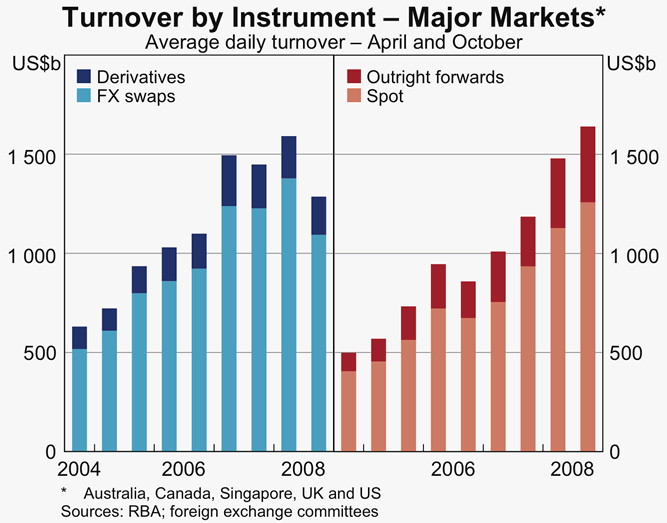
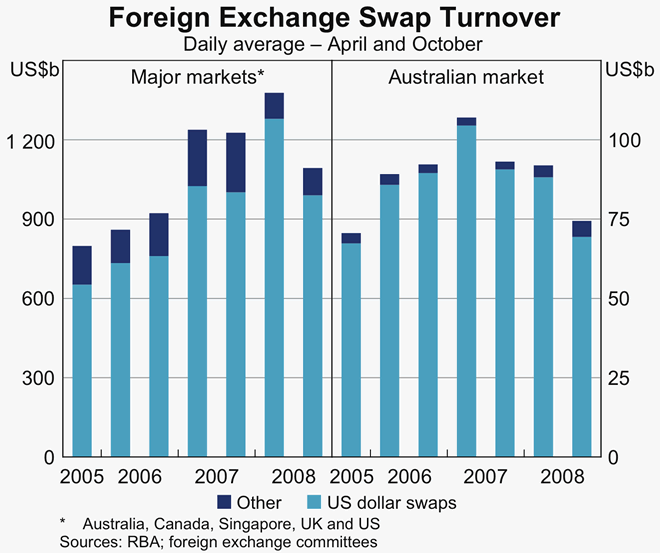
One likely explanation for the decline in foreign exchange swaps turnover is the extreme counterparty concerns that followed the collapse of Lehman Brothers which caused a dislocation in many markets. The fall in USD swaps turnover coincides with the large expansion of the Federal Reserve's USD swap lines with foreign central banks. These swap lines had been introduced in December 2007 between the Fed, ECB, Bank of England and Swiss National Bank to ease the ever-increasing cost of raising US dollar funds in global markets, and to address the tensions in the swap market.
In October 2008, as the foreign exchange swap market became particularly dislocated, and the global demand for US dollars intensified, the existing swap lines were increased substantially, ultimately without limit, and were also extended to a number of other central banks including the Reserve Bank of Australia.[3] The swap lines involve the foreign central bank auctioning US dollar repos to its domestic counterparties against domestic collateral. This allows the problem of counterparty risk, which was a key factor in the market dislocation, to be side-stepped.
In October, these auctions were heavily subscribed across all markets, including Australia, with the amount outstanding rising to US$500 billion by the end of the month (Graph 3). These swaps do not appear in the data recorded by the Foreign Exchange Committees.
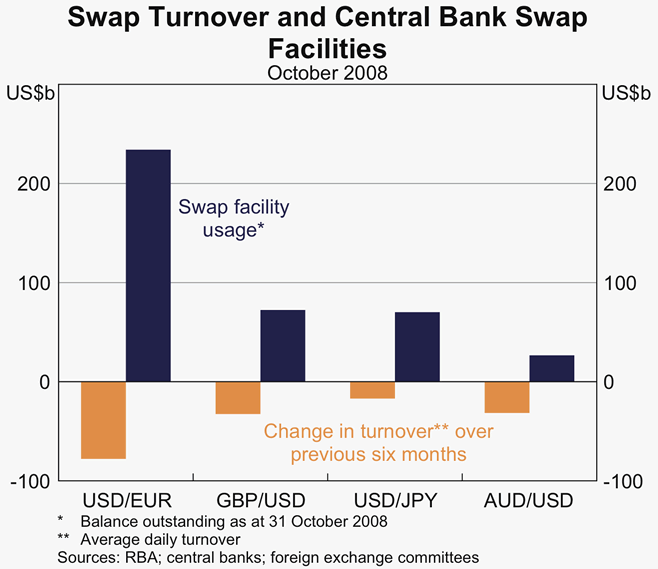
The swaps offered by the central banks are priced at a spread to a ‘normal’ market price, such that as market conditions improve and the market swap rate starts to decline, the central bank facility is no longer cost-effective. In recent weeks, the take-up of these facilities globally has declined substantially. In Australia, the three most recent auctions have all been undersubscribed, with one of the auctions receiving no bids.
In contrast to the developments in foreign exchange swap markets, turnover in foreign exchange spot markets continued to grow through to October 2008. Indeed it is likely that the crisis has contributed to the growth in spot turnover over this period. Spot foreign exchange turnover in October was 12 per cent higher than in April and was triple the volume of 2004/05. This growth has been widespread across foreign exchange centres and across currencies.
There are a number of factors that are likely to have contributed to the rapid growth in spot turnover in the period prior to October 2008. In particular, widespread repatriation of funds has resulted in additional turnover in foreign exchange markets. Another factor is that the dramatic pick-up in both asset and exchange rate volatility has forced investors to rebalance international portfolios and their associated hedge positions more frequently.
High-frequency data sourced from electronic broking platforms on the amount of activity in interdealer foreign exchange spot market show that there appears to be a very close relationship between volatility and the level of activity (as measured by turnover or the number of trades). Using such micro, transaction-level data provided by Reuters, we can relate developments in market activity, volatility and liquidity in the spot market.[4]
Over time, and at the peak of the global financial turbulence in late 2008 in particular, there is a distinct positive correlation between the number of trades in the interdealer spot market and the daily intraday range in the AUD/USD (Graph 4). It is worth noting, however, that the number of trades on interdealer electronic platforms is not a direct measure of turnover, nor liquidity. When exchange rate volatility reached its peak in October 2008, the number of trades increased to around three times the pre-2007 level, while turnover was only 1½ times as high. Probably as a direct result of the heightened volatility, there has been a shift in the share of turnover toward the interdealer market and a fall in the packet size of trades, as measured in US dollars, although the Australian dollar size of the trades has been little changed. The choice of the currency that is being used to measure turnover always needs to be borne in mind when assessing such data.

The link between volatility and the number of trades arises for a number of reasons, in particular the reaction of market participants to news. When news arrives, participants adjust their positions and the price they are willing to pay in the market, driving both an increase in the number of trades and a change in the exchange rate. This pattern is most clear at an intraday frequency. Graph 5 shows the number of trades in AUD/USD on the interdealer electronic trading platform Reuters 3000 and the change in the exchange rate across 10-minute intervals of the day, averaged over the period from 2000–2008. Volatility and the number of trades clearly spike at the time of data releases in the US and Australia. It is also worth noting the clear spike in the number of trades and volatility around the London fix.[5]
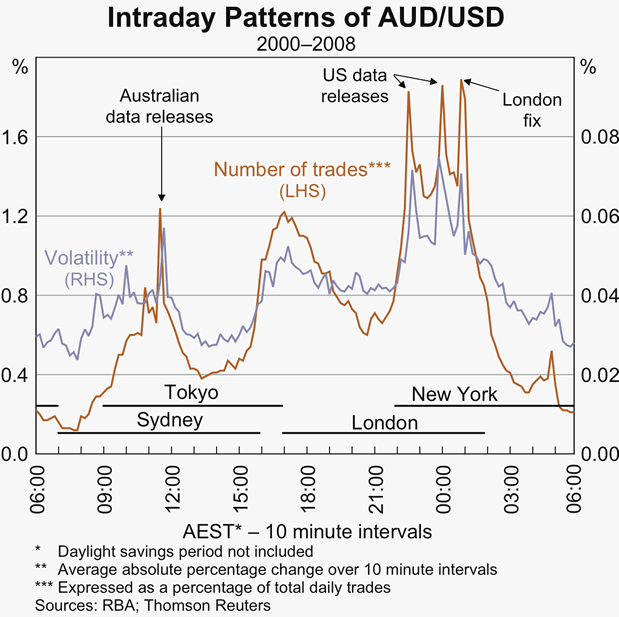
Volatility and turnover are both higher during the overlap of the London and New York sessions. While there is no Australian news during this period, the exchange rate against the US dollar is obviously influenced by news about the US economy as well as other developments that might affect the outlook for global growth and commodity prices. In recent times, the difference in volatility between the offshore and onshore sessions has widened, most likely reflecting the increased volume and importance of news coming out of the US.
In addition, big movements in exchange rates themselves may generate larger turnover in the spot market. First, the widespread use of algorithmic or momentum-based trading rules would imply that in periods where exchange rates move quickly, turnover should increase. Second, a dealer might respond to increased volatility by lowering their holdings of foreign exchange to minimise inventory risk. Increasing the speed at which the dealer passes on customer orders to the interdealer market would increase the frequency of trades and the volume of turnover in the market. We can infer that this has occurred by the increased share of turnover of the interdealer market.
Another possible explanation is that investment strategies which tend to pay off more under benign conditions, such as leveraged carry trades, will be unwound once the exchange rate moves sufficiently to trigger stop/loss orders. Market liaison suggests that the unwinding of leveraged carry trades contributed considerably to the sharp depreciation in the Australian dollar in August 2007 and to the Australian dollar's depreciation over the second half of 2008.
While it is difficult to document the size and effect of carry trades directly, an indication can be gleaned from the behaviour of Japanese retail investors. These investors have a small but growing presence in the Japanese foreign exchange market, including the AUD/JPY market.[6] Daily average turnover of Japanese foreign exchange margin trading increased to around US$70 billion in the September quarter 2008, seven times the volume two years prior, driven by an increase in the number of small account holders (Graph 6). This sector now accounts for around 20 per cent of total foreign exchange turnover in Japan. Around 8 per cent of foreign exchange margin trading is conducted in AUD/JPY.
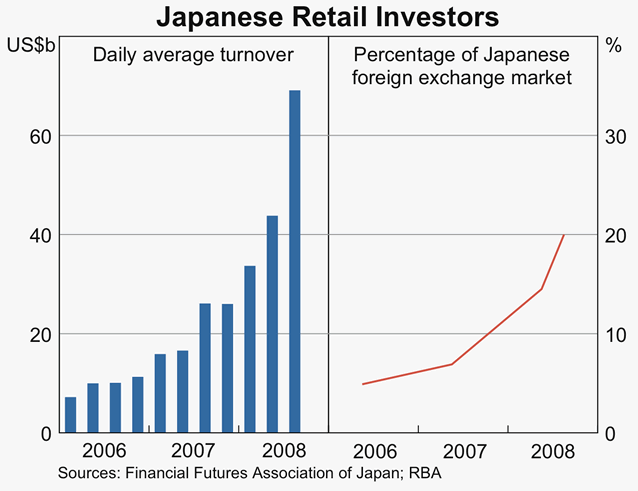
Japanese retail investors consistently hold net long positions against the yen. The positions have been largest for the so-called carry currencies, the high-yielding New Zealand dollar, Australian dollar and the British pound sterling (Graph 7), although the largest net long positions over 2006 and 2007 were taken in the US dollar, despite this trade offering a lower interest rate differential.
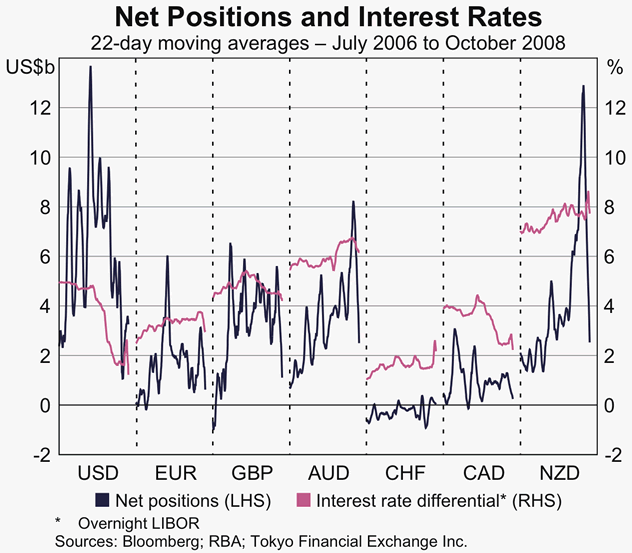
In prior years, the carry trade against the Australian dollar had been very profitable. Graph 8 shows the return where the investor funds themselves in yen and invests in Australian dollars at 90 days and continually rolls the position. It shows the part attributable to the interest differential, with the difference between the two lines accounted for by the currency movement. The appreciation of the Australian dollar against the yen boosted returns until 2008 but the sharp depreciation since then has wiped out the positive carry. If an investor entered the market in 2003 and had maintained their position, this investment would still be profitable. If the investment had been initiated any time later, it would now be yielding a loss.
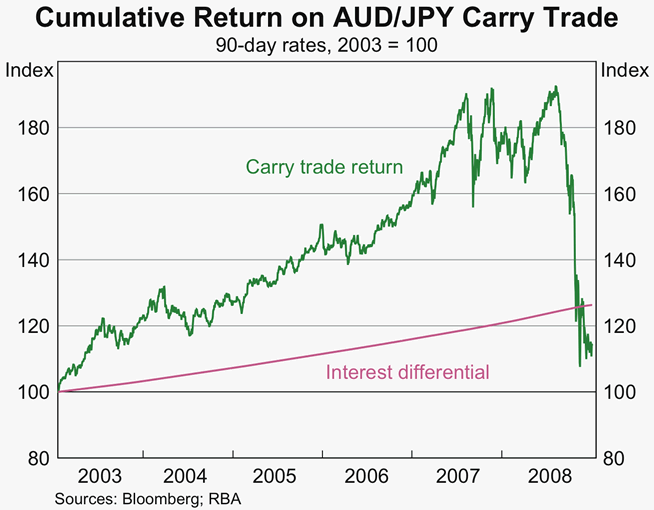
To reduce risk, these retail accounts contain stop/loss constraints that automatically reduce positions once losses hit a threshold. Thus, positions can unwind quickly given a sharp change in the exchange rate. This was clearly evident in August 2007, and again in October 2008 (Graph 9).
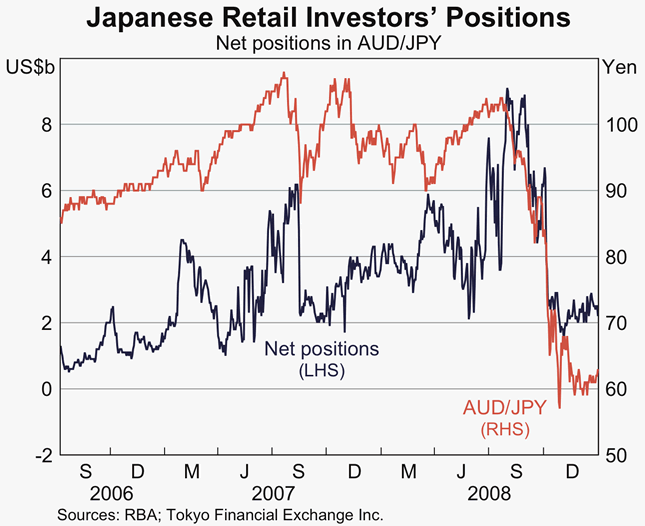
Another notable feature of the extreme volatility in late 2008 is that liquidity in the spot market, which had been fairly stable through early 2008, deteriorated quickly. On several occasions market liaison reported a lack of depth in the market, and we observed sharp price jumps between trades. Most memorably, the Australian dollar depreciated 9 per cent against the US dollar, and 11 per cent against the yen, in six hours of trading on the evening of the 8th of October.
Measuring liquidity is difficult: as noted above, turnover is one often-used metric but at times this can be misleading. A potentially better measure of liquidity is the difference between the best bid and best ask in the Reuters system at any time, hereafter referred to as the best bid-ask spread. Dealers should be willing to place limit orders in the system at close to the central price when the market is more liquid, i.e. when they can quickly offload trades thereby reducing inventory risk.
Under normal market conditions, the relationship between turnover and liquidity is generally positive; which is to say that when there is more turnover in the market, bid-ask spreads tend to be lower. We can see this quite clearly in the intraday data.[7] During the low-volume periods for AUD/USD trade, for example immediately after the close of New York and before the open of Sydney, the spreads are quite high (Graph 10). However, a fairly low and even spread is maintained through the bulk of the day, when the volume of trading is sufficient to provide liquidity in the market. On average, the spread for the AUD/USD is consistent with its ranking in spot turnover, i.e. a little higher than that for the GBP/USD (whose turnover is higher) and similar to that for the CAD/USD (whose global turnover is lower).
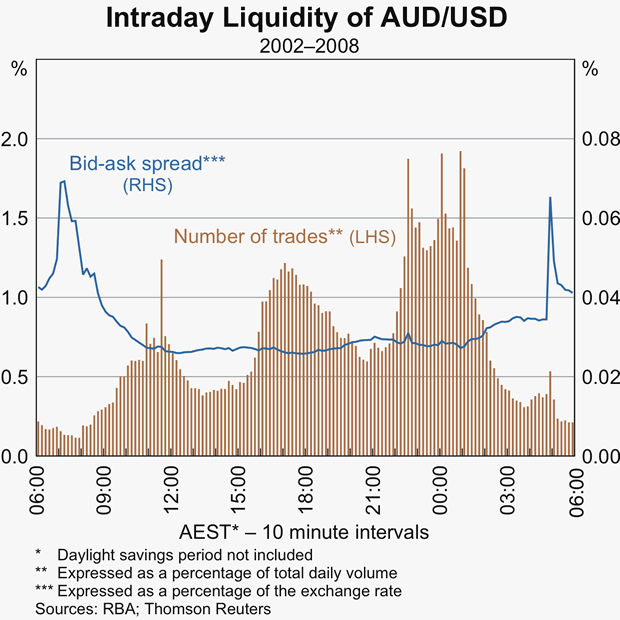
However, this relationship broke down in October 2008. Leading up to October, turnover and volatility were elevated and the AUD/USD market was reasonably liquid (Graph 11). In October, turnover and volatility increased further but liquidity deteriorated significantly. The sharp fall in the exchange rate was associated with a large reduction in a number of Australian dollar positions, at times resulting in one-sided markets. A sizeable number of these transactions were a result of investors being forced to close out profitable Australian dollar investments to offset losses in other asset classes (see below). In this sort of market, dealers are much less likely to enter orders into the trading platform, so that the depth in the market is eroded and large jumps in the price can occur between trades.
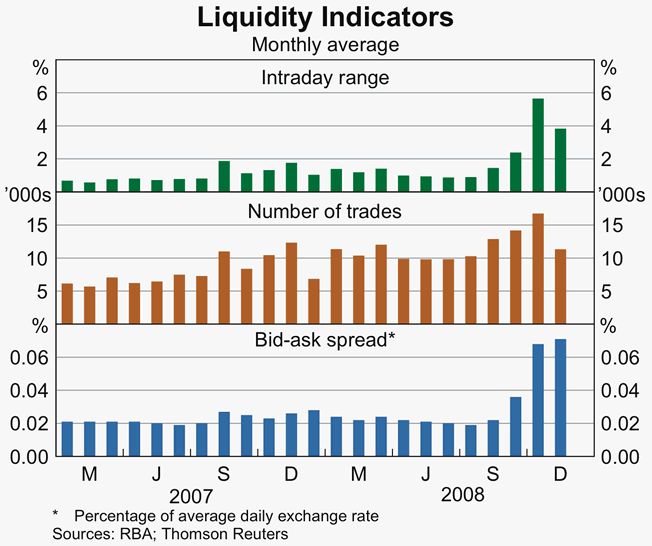
In this environment the Bank stepped in to enhance liquidity in the market to ensure that price adjustments were as smooth as possible. As is always the case in the Bank's interventions in the foreign exchange market, the Bank was not targeting any particular level of the exchange rate but rather seeking to enhance the functioning of the market. One development that became apparent through the Bank's transactions during this period was the small size of the trades and the reluctance of market participants to hold any significant inventory of positions for any length of time. This was in marked contrast to the experience in earlier episodes of intervention such as after the Asian crisis and in 2001, when there were large positions being taken in the market.
The events of October persisted into November. The number of trades fell from the peak in October, although remained relatively high. In part, this may reflect a more functional market, with a lower requirement for spot transactions. It may also reflect the relative stability in the exchange rate compared to October, although volatility remained elevated relative to earlier periods. However, the bid-ask spread did not come down – it actually increased further in the month suggesting that liquidity in the AUD/USD spot market remained strained. The Bank again sought to enhance liquidity in the market on a few occasions during November. Subsequent data suggest an improvement in liquidity in December although the bid-ask spread has not returned to its pre-October levels.
The recent deterioration in liquidity applies equally to other currency pairs. While the Reuters data available to us do not provide a reliable indicator of developments in the two most high-volume currency pairs, the JPY/USD and EUR/USD, we can examine developments across the next three pairs. The widening in the bid-ask spreads indicates liquidity deteriorated sharply across all these currency pairs in October (Graph 12).
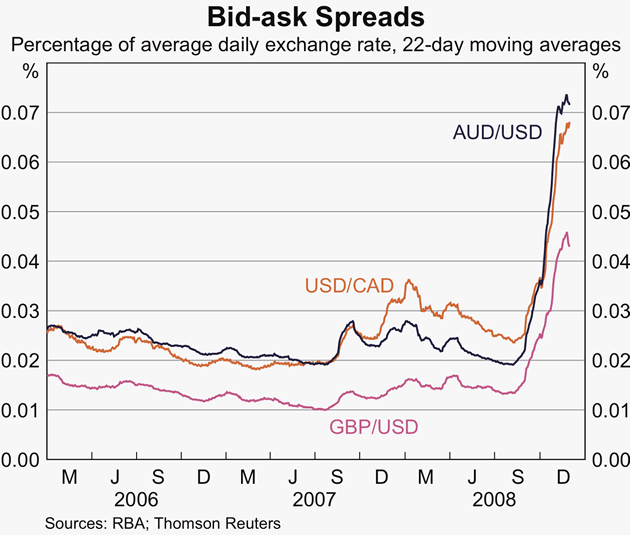
Finally, two other notable developments in the foreign exchange market occurred during this period. First, there was a high correlation between the Australian dollar and other asset classes. Second, and relatedly, there were large movements in all these assets in the last two hours of trading on the New York Stock Exchange. Graph 13 shows the high correlation between the Australian dollar and the S&P 500, but there were similarly high correlations with many other assets during this time. It appears that investors were liquidating positions across the board during those periods, although it is also true that large increases in the S&P 500 and simultaneous large appreciations of the Australian dollar occurred on various days during this time. It appears that some investors were forced to sell down a wide portfolio of assets in a short period of time, including positions that were otherwise profitable.

This saw an accentuation of the pattern that has been observed for a number of years in the Australian dollar, where much of the movement occurs offshore, notwithstanding the release of Australian data during the Australian trading day (Graph 14).
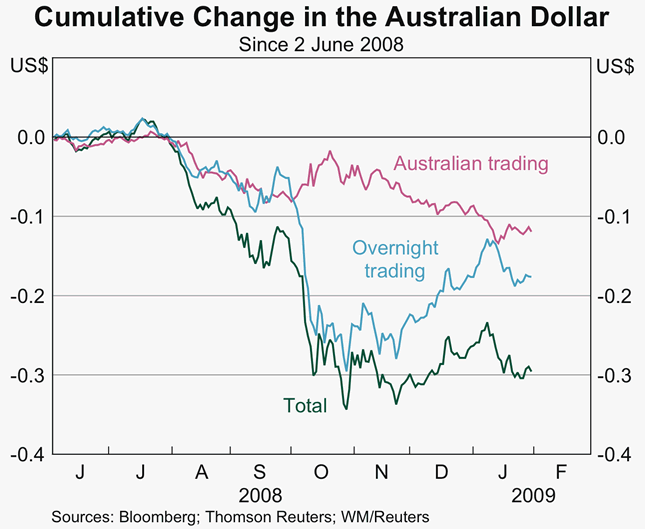
Conclusion
This article has documented some recent developments in the Australian foreign exchange market. The market has experienced very strong growth over a number of years and including through much of the recent period of financial turbulence. The article has highlighted some aspects of the way the market has functioned during a period of high volatility and high stress. The foreign exchange market, on the whole, while recording very high volatility, has functioned more effectively than many other markets. This has been particularly true of the spot market. Nevertheless, in October, as financial dislocation increased significantly, conditions in both the spot foreign exchange market and the foreign exchange swap market deteriorated, warranting some intervention to ensure the smooth functioning of the market.
Footnotes
This article was co-authored by Guy Debelle, Assistant Governor (Financial Markets), Patrick D'Arcy and Crystal Ossolinski. It draws on work conducted in the Market Analysis section of Financial Markets Group over recent years, including by Benn Robertson, Michael Plumb, Kristina Clifton, Andrew Zurawski and Emily Poole. It was presented by Chris Ryan (Head of International Department) to the Westpac & Global Pensions Currency Forum in Sydney on 16 February 2009. [1]
See <http://www.rba.gov.au/afxc/>. Japan collects similar data on an annual basis for the month of April. [2]
For information on the size and use of US dollar swap lines see ‘Box B: US Dollar Swap Arrangements between Central Banks’, Statement on Monetary Policy, November 2008, pp 23–25. [3]
These data report the best bid and best ask quoted by the Reuters 3000 interdealer electronic broking platform through time as well as the price of trades executed by dealers through the platform. They are provided to the RBA by Securities Industry Research Centre of Asia-Pacific (SIRCA). The interdealer market accounts for just over half of all spot turnover in AUD/USD, with the Reuters 3000 platform accounting for a large proportion of this turnover. Market conditions in the interdealer market should, therefore, reflect conditions in the wider foreign exchange spot market. [4]
Plumb M and K Clifton (2007), ‘Intraday Currency Market Volatility and Turnover’, RBA Bulletin, December, pp 1–9. [5]
See Zurawski A and P D'Arcy (2009), ‘Japanese Retail Investors and the Carry Trade’, in this issue of the Bulletin, pp 1–8. [6]
For a further discussion of liquidity in the interdealer AUD/USD market over time see Poole E and P D'Arcy (2008), ‘Liquidity in the Interdealer Foreign Exchange Market’, RBA Bulletin, December, pp 1–6. [7]